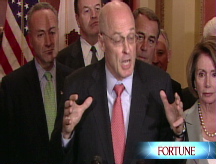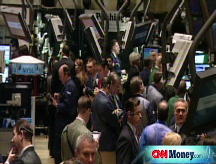Bond yields soar on government rescue
Treasury prices plummet, pushing yields sharply higher, after Paulson unveils a plan to help strapped banks get rid of their troubled mortgage assets. Dollar mixed.
NEW YORK (CNNMoney.com) -- Bond prices tumbled on Friday after the government announced an unprecedented and far-reaching plan to rescue the troubled banking industry by absorbing poisonous mortgage assets.
Separately, the U.S. dollar was mixed against other most currencies on Friday.
President Bush and Treasury Secretary Henry Paulson said the plan, likely to cost hundreds of billions of dollars, should return some confidence to Wall Street.
The benchmark 10-year note dropped 2 9/32 to 101 16/32, and its yield rose to 3.81% from 3.54% late Thursday. Bond prices and yields move in opposite directions.
The 2-year note fell 1 to 100 10/32, and its yield rose to 2.17% from 1.68% late Thursday. The 30-year bond dropped 3 18/32 to 101 23/32, while its yield rose to 4.39% from 4.18%.
The decrease in bond prices Friday showed that "the flight to quality is now reversing," said William Larkin, portfolio manager at Cabot Money Management.
Treasury prices ping-pong: Earlier during the week, investors flocked to Treasurys in the wake of Lehman Brothers' (LEH, Fortune 500) bankruptcy filing and the government's $85 billion loan to AIG (AIG, Fortune 500), sending the yield on the 10-year note to a 5-year low of 3.25%.
Investors purchased Treasurys in a "complete panic" as Wall Street collapsed, said Larkin. Fear seized the market after Merrill Lynch (MER, Fortune 500) agreed to sell itself to Bank of America (BAC, Fortune 500) and speculation about the health of Morgan Stanley (MS, Fortune 500) and Goldman Sachs (GS, Fortune 500) mounted.
But on Friday, with the government's rescue plan providing the financial sector with a shot of confidence, investors dropped Treasury bills and ran back to stocks. "The Treasury market got whipsawed," Larkin explained. The Fed's announcement "changed the game a little bit."
The Dow Jones Industrial Average was up more than 350 points in late trading, having jumped as much as 450 points earlier Friday. Not only were investors cheering the Fed's plan, but bank stocks were supported because of the restrictions put on shorting selling, said Larkin.
"The government is now going to back money market investments so now you don't have to go into the Treasury market, you can go directly into a money market," said Larkin. "The government is going to become like a sovereign fund - they will become the buyer of last resort for a lot of these illiquid assets," he explained.
3-month T-bill: The yield on the 3-month Treasury bill rose to about 0.91% Friday from 0.22% Thursday after the Treasury Department said Friday it would insure up to $50 billion in money-market mutual fund investments.
Rates on the 3-month bill fell to their lowest level since World War II Wednesday as the financial crisis reached a fever pitch.
Money-market funds are closely tied to the 3-month Treasury bill, which is typically viewed as one of the safer short-term bond investments.
Investors in money-market fund tend to rely on them to offer a relatively steady yield but the events of the past week threatened these payouts as demand ballooned for 3-month bills.
"The 3 month T bill has always been a perfect asset," for money-market mutual funds that need to keep a high percentage of their assets easily accessible, Larkin said.
Institutions knew that they can move into and out of Treasury bills very quickly until earlier this week. Larkin said Friday's developments should reduce demand for 3-month bills going forward, leading to a higher yield over time.
Currencies: The dollar ended lower against most major currencies, except for the Japanese yen.
The 15-nation euro cost $1.4492, up from $1.4348 late in the day Thursday. The greenback bought ¥107.22, up from ¥105.44 late Thursday.
The Federal Reserve's announcement that it would absorb bad debt incurred by financial institutions "provided that comforting arm around the shoulder that the market was looking for," said Gareth Sylvester, senior currency strategist at HFIX in San Francisco.
As investors moved back into stock markets around the globe and out of U.S. government bonds, the dollar lost ground against most major currencies. Earlier in the week, when Wall Street was reeling from the Lehman bankruptcy, the dollar had actually seen a boost from the volume of investors moving to Treasury bills.
"Investment has been out of U.S. government Treasurys and back into global equity markets," said Sylvester, "and that is why the U.S. currency has been on the back foot against other major currencies." ![]()






